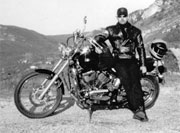By Eddie Smyth
The next day was spent visiting several sites around Albert. There are so many that an attempt to stop at every one you pass will take you months. To visit them all in Northern France would be a lifetime’s work. Around every corner it seems there is a cemetery or monument paying tribute to those who fell in the Great War and WWII. It’s best to work a circuitous route for the day.
Memetz
If you are Welsh, Memetz is the best starting point. This trip begins with visiting a battle site where a commemorative sculpture of a Welsh Dragon dominates the location.
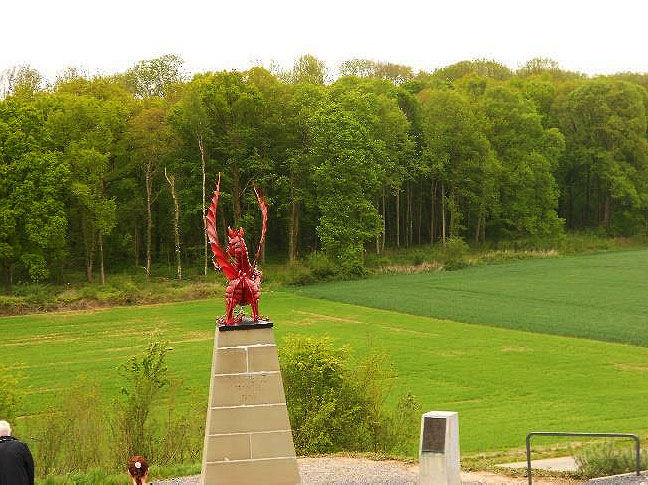 It is found down a farm track but the road has been improved recently and the history of the battles that raged here will give you so much food for thought about the pointless loss of life for what seems little more than a farmers’ field and a stretch of woodland that provides you with a mental template for every other battle site and cemetery that you visit on a trip like this. It always stuns me into deep, reflective thought.
It is found down a farm track but the road has been improved recently and the history of the battles that raged here will give you so much food for thought about the pointless loss of life for what seems little more than a farmers’ field and a stretch of woodland that provides you with a mental template for every other battle site and cemetery that you visit on a trip like this. It always stuns me into deep, reflective thought.
Delville Wood
From Memetz, it’s a short route to Delville Wood. There are two highlights here. The first is for family reasons. Joy’s Mother, Rose brought a wreath to lay at the headstone of her Grandfather who died in battle in the Great War. There was a solemn but not morbid, moment as four generations stood behind the headstone for a keepsake photograph. The second reason for picking this site is the South African Memorial site directly across the road from this perfectly well kept cemetery of allied forces soldiers who fell in battle.
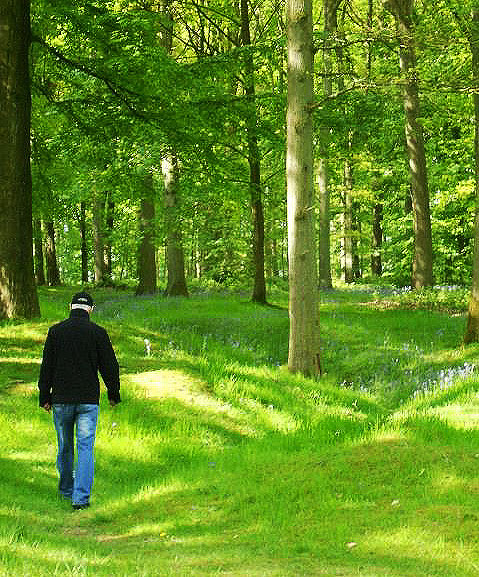 The South African memorial building is surrounded by a forest of healthy adult trees and lush grass. Images of the conditions of the area 100 years ago are very different. I stood away from the others and listened to the chatter of so many wild birds in the trees. This place has atmosphere. There are avenues between the trees all named after Streets in the UK. The ground was sprinkled with bluebells and cornflowers and folk have seen deer slipping quietly between the trees on occasion. You could almost picture the Telly Tubbies sitting down for a picnic amongst the clumps of grassy knolls that betray the history of this landscape. The whole site is a fitting memorial in itself. Inside the memorial building there are scores of stories, photographs and clips of heroic actions by South African soldiers and labourers who came to France to fight against the Germans.
The South African memorial building is surrounded by a forest of healthy adult trees and lush grass. Images of the conditions of the area 100 years ago are very different. I stood away from the others and listened to the chatter of so many wild birds in the trees. This place has atmosphere. There are avenues between the trees all named after Streets in the UK. The ground was sprinkled with bluebells and cornflowers and folk have seen deer slipping quietly between the trees on occasion. You could almost picture the Telly Tubbies sitting down for a picnic amongst the clumps of grassy knolls that betray the history of this landscape. The whole site is a fitting memorial in itself. Inside the memorial building there are scores of stories, photographs and clips of heroic actions by South African soldiers and labourers who came to France to fight against the Germans.
As you leave the site there is a memorial stone depicting a football match played between the warring armies and in the nearby village there is a statue of a Scottish soldier replete with bagpipes and kilt.
Lochnagar Crater
A trip to Lochnagar Crater as we headed back a little towards Albert made for a different type of memorial. At the end of a short track a fenced of area protected visitors from slipping down into a crater the size of a French town centre and deep enough to make you realise it was no wonder the blast of the underground bomb that made this dent in the earth could be heard as far away as London. While the Germans watched the surrounding landscape for attackers, the British burrowed underneath their depot and blew it up, taking several hundred tonnes of soil with it. Coaches are no longer allowed to drive this close and turn round because recent maintenance work has revealed underground bunkers just below the surface of the road. More excavations are planned and more history of this remarkable site will most certainly be revealed.
From here you can see the golden top of the cathedral in Albert. The Germans used it for sighting and distance practice for their big guns. No wonder it was deemed necessary to take this holding out by any means possible.
Thiepval
Next up is Thiepval. It’s not far from here. On the way there we had to screech to a halt as a van came haring round the bend straight at us on the wrong side of the road. The driver swerved at the very last moment to avoid a head on collision and severe injury to all and all he could do was wave sheepishly and apologise as he probably soiled his trousers at the same time. He must have driven at least a mile along the road from Thiepval site as there are no side roads along that stretch. The van had a British number plate: It’s easy to forget which side of the road you should be driving on when the roads are so less busy than in the UK.
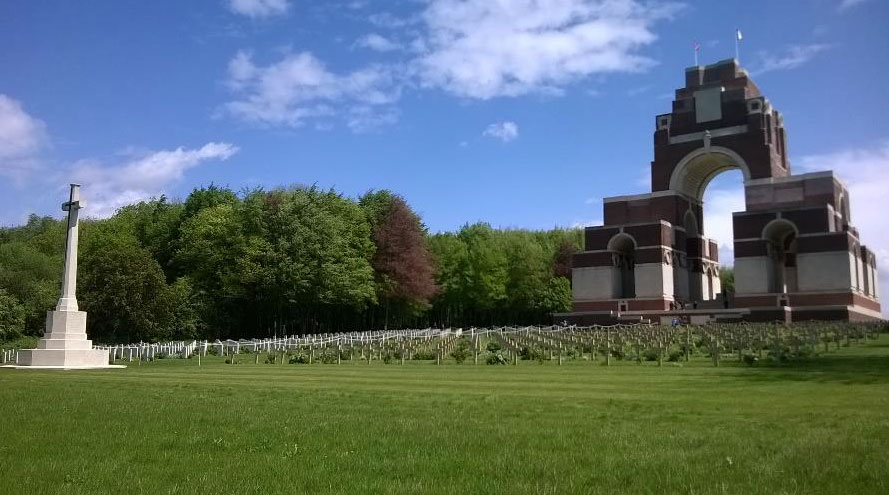 The memorial at Thiepval is massive and very distinctive. It can be seen from miles around too. It is a wonderful monument and site as a whole but the design, by Sir Edwin Lutyens who also built the Cenotaph in London, is the ugliest building in the whole of France, in my uneducated opinion. It could easily be mistaken for a sink estate tower block in South London. However, the blocks the building stacks up on displays the names of 72,000 soldiers from Britain and South Africa who fell at the Somme. Poignant and thought provoking. It tells a big story and despite its uncomely features it commands respect.
The memorial at Thiepval is massive and very distinctive. It can be seen from miles around too. It is a wonderful monument and site as a whole but the design, by Sir Edwin Lutyens who also built the Cenotaph in London, is the ugliest building in the whole of France, in my uneducated opinion. It could easily be mistaken for a sink estate tower block in South London. However, the blocks the building stacks up on displays the names of 72,000 soldiers from Britain and South Africa who fell at the Somme. Poignant and thought provoking. It tells a big story and despite its uncomely features it commands respect.
Time for coffee and a cake. We found a nice British run café in a small village which provided adequate refreshment and a little morsel to keep me going until lunchtime.
Ulster Regiments’ Memorial
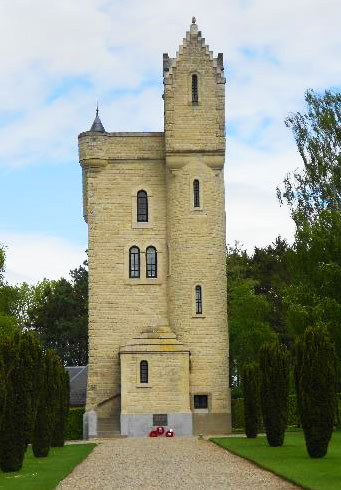 The next location was the Ulster Regiments’ memorial at Memorial Irlandais. It’s a fine building with wreaths and coats of arms of all the Ulster forces that fought here. I spent quite a while here reading the plaques and the notes and photographing the various coats of arms. Joy pointed out to me the memorial outside in a quiet garden at the rear of this tower erected and dedicated to the Orange Order and their role in the Great War.
The next location was the Ulster Regiments’ memorial at Memorial Irlandais. It’s a fine building with wreaths and coats of arms of all the Ulster forces that fought here. I spent quite a while here reading the plaques and the notes and photographing the various coats of arms. Joy pointed out to me the memorial outside in a quiet garden at the rear of this tower erected and dedicated to the Orange Order and their role in the Great War. 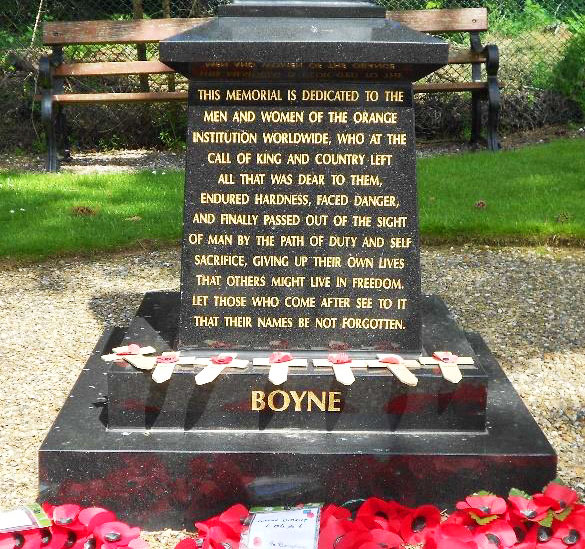 It was a special moment for me to reflect on all those who fought and died from all quarters of the British Isles. I signed the visitor’s book and wrote in the comments section. “Sure, it’s only six counties, but oh what renown”.
It was a special moment for me to reflect on all those who fought and died from all quarters of the British Isles. I signed the visitor’s book and wrote in the comments section. “Sure, it’s only six counties, but oh what renown”.
We headed then to another café, owned and run by a British family. Very well put together and very well run. The paddock behind the cluster of buildings in the tiny village contained a few sheep, several chickens and a couple of retained trenches, authentic in almost every way. Health and Safety officials in petty England would have this field sealed off, not least for the pool of muddy water that lay underfoot along the bottom of the trenches. It was certainly interesting.
Beaumont Hamel and the Newfoundland Memorial
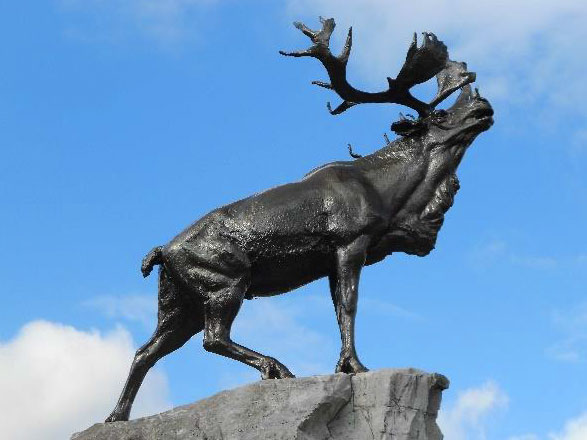 Afterwards, we took the short route to Beaumont Hamel and the Newfoundland Memorial. This is another amazing site, well-kept and there are plenty of volunteer staff on hand to guide you round the place. Not a Welsh dragon here but a caribou, braying across the no man’s land that was the last step so many soldiers took as they were ordered to ‘go over the top’ of the trenches only to be mown down be the enemy over the clearing.
Afterwards, we took the short route to Beaumont Hamel and the Newfoundland Memorial. This is another amazing site, well-kept and there are plenty of volunteer staff on hand to guide you round the place. Not a Welsh dragon here but a caribou, braying across the no man’s land that was the last step so many soldiers took as they were ordered to ‘go over the top’ of the trenches only to be mown down be the enemy over the clearing.
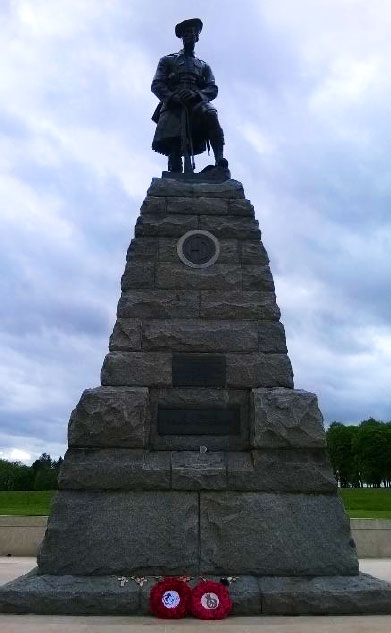 Zig zag channels reveal where many of the trenches were dug. A ravine at the very bottom of this site tells you how murderous (it’s not suicide if the General orders you to charge at the enemy with little more than a tin hat and a rain sodden uniform to protect you) it was to even attempt to cross this field. At the bottom end of this circuitous path there is a cemetery dedicated to Scottish soldiers who fell here and farther round is a statue of a kilted highlander and a mass grave with so many regimental names carved into the headstones.
Zig zag channels reveal where many of the trenches were dug. A ravine at the very bottom of this site tells you how murderous (it’s not suicide if the General orders you to charge at the enemy with little more than a tin hat and a rain sodden uniform to protect you) it was to even attempt to cross this field. At the bottom end of this circuitous path there is a cemetery dedicated to Scottish soldiers who fell here and farther round is a statue of a kilted highlander and a mass grave with so many regimental names carved into the headstones.
The beautiful avenue of trees that lead me back towards the Caribou sculpture belied the stark and destroyed land that must have lay fallow for decades after all those bombs and shells reshaped the meadows.
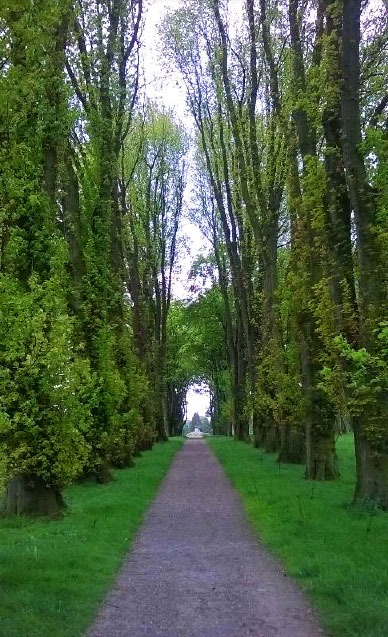 The day was almost complete. English, Welsh, Scottish, Irish, and Ulster’s own battalions have left their dead here in France. With other nations in the Commonwealth represented and respected too it was a great way to spend the warm spring day visiting these wonderfully well kept, and well run sites. Nobody forgets the sacrifices made and the generations of inhabitants of this region who succeed their forefathers continue to maintain these reminders of battles that were meant to end all battles on European soil.
The day was almost complete. English, Welsh, Scottish, Irish, and Ulster’s own battalions have left their dead here in France. With other nations in the Commonwealth represented and respected too it was a great way to spend the warm spring day visiting these wonderfully well kept, and well run sites. Nobody forgets the sacrifices made and the generations of inhabitants of this region who succeed their forefathers continue to maintain these reminders of battles that were meant to end all battles on European soil.
We made our way back to Albert and the day that was arranged for Joy’s parents to enjoy was a complete success: They loved every minute of it.
Tomorrow we head north and east. Ypres in Belgium is the last place name on my directions list slipped into the pocket of my tank bag. I am on the road again.
To be continued…
